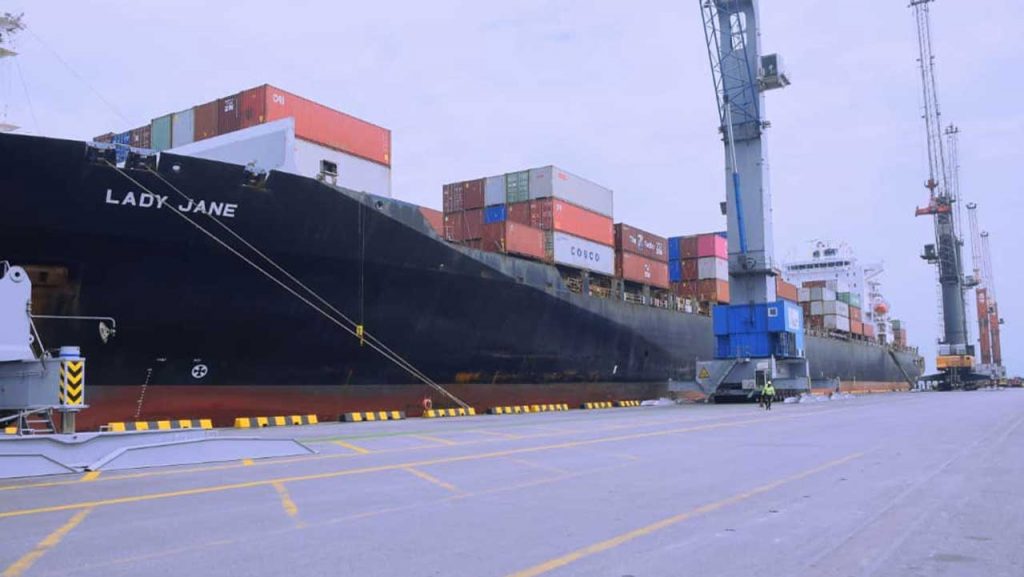Oversupply of Containers Drives Down Secondhand Prices

SHIP AT BERTH
(TME) In the latest sign of the reversal of fortune in the container shipping markets, an oversupply of containers is emerging resulting in step declines in secondhand container prices worldwide. While global shipping volumes remain high, slowing demand and better utilization are contributing to a near-term decline in the price of boxes that is expected to slowly level off as the peak shipping season ramps up toward the end of year retail selling season.
“As markets reopen and demand softens, the oversupply is a natural outcome of demand-supply forces balancing at new levels,” said Christian Roeloffs, Co-founder and CEO of Container xChange, a tech platform for the logistics of container movement. “The oversupply situation does not come as a surprise because the average container prices and leasing rates have been declining globally since September-October 2021.”
In a new analysis of the market over the past year, Container xChange highlights that the price of secondhand boxes has been on a steady decline in both the United States and Northern Europe ports as well as China since August of 2021. The price of boxes is outpacing the decline in freight rates which Container xChange highlights are down 20 percent since the beginning of the year. By comparison, secondhand container prices, however, had fallen anywhere from a quarter to a third in the 11 months since August 2021.
The strongest price declines have come in both the large Chinese ports as well as the major container ports of Northern Europe. Prices in China are down by up to a third from around $6,000 in the ports of Shanghai, Ningbo, and Qingdao in August 2021 to approaching $4,000 in June of this year. Container prices in Rotterdam, Hamburg, and Antwerp saw a similar decline moving from over $4,000 to just under $3,000 while in the United States pricing has been more erratic. Generally, U.S. prices came down from between $3,500 to $4,000 to approaching $3,000 but recently prices in the Southern California ports rebounded from a low in April back to levels of $3,500 to $3,700 in June.
“We’ve said it before that the main factor that has driven up prices much more than the historical levels has been a supply-side crunch over the past two years because of lengthening turnaround times of containers caused by supply chain congestions,” said Roeloffs. “That still holds true. We still have about 10 percent of transport capacity tied up and removed from the value chain. Demand on the other hand has softened now.”
Market analysts Drewry last week highlighted the depth of the oversupply that they believed was developing for containers. Their data shows a current glut of nearly six million TEU on the world market. They estimated that the global pool of shipping containers increased by 13 percent to almost 50 million TEU in 2021, three times the prior growth trend. However, they predicted it would be a short-ter m phenomenon as the markets rebalanced after the two-year surge in volumes and prepare for the coming wave of new containership introductions between 2023 and 2026.
Container xChange highlights that there was likely panic buying by many of the world’s leading carriers driving box production to record levels. Seeking to deal with the growing backlogs and congestion across the supply chain the carriers increased the supply of containers, but now as demand is slowing the boxes are piling up in container yards at the major ports.
“In a scenario where we assume that the global supply chain disruptions will fade away with time, there will be higher box productivity,” writes Container xChange. “We will need fewer boxes per unit of cargo,” they forecast in the near term. They also point to rising inflation which may dampen consumer demand and could also slow the need for boxes to export goods.
With equipment likely to pile up across the supply chain, Container xChange predicts, that “carriers will rush to get rid of their older equipment. Secondhand container prices will continue to slide gradually reaching a new normal level while the new market will dry up.”
*Culled from The Maritime Executive
“As markets reopen and demand softens, the oversupply is a natural outcome of demand-supply forces balancing at new levels,” said Christian Roeloffs, Co-founder and CEO of Container xChange, a tech platform for the logistics of container movement. “The oversupply situation does not come as a surprise because the average container prices and leasing rates have been declining globally since September-October 2021.”
In a new analysis of the market over the past year, Container xChange highlights that the price of secondhand boxes has been on a steady decline in both the United States and Northern Europe ports as well as China since August of 2021. The price of boxes is outpacing the decline in freight rates which Container xChange highlights are down 20 percent since the beginning of the year. By comparison, secondhand container prices, however, had fallen anywhere from a quarter to a third in the 11 months since August 2021.
The strongest price declines have come in both the large Chinese ports as well as the major container ports of Northern Europe. Prices in China are down by up to a third from around $6,000 in the ports of Shanghai, Ningbo, and Qingdao in August 2021 to approaching $4,000 in June of this year. Container prices in Rotterdam, Hamburg, and Antwerp saw a similar decline moving from over $4,000 to just under $3,000 while in the United States pricing has been more erratic. Generally, U.S. prices came down from between $3,500 to $4,000 to approaching $3,000 but recently prices in the Southern California ports rebounded from a low in April back to levels of $3,500 to $3,700 in June.
“We’ve said it before that the main factor that has driven up prices much more than the historical levels has been a supply-side crunch over the past two years because of lengthening turnaround times of containers caused by supply chain congestions,” said Roeloffs. “That still holds true. We still have about 10 percent of transport capacity tied up and removed from the value chain. Demand on the other hand has softened now.”
Market analysts Drewry last week highlighted the depth of the oversupply that they believed was developing for containers. Their data shows a current glut of nearly six million TEU on the world market. They estimated that the global pool of shipping containers increased by 13 percent to almost 50 million TEU in 2021, three times the prior growth trend. However, they predicted it would be a short-ter m phenomenon as the markets rebalanced after the two-year surge in volumes and prepare for the coming wave of new containership introductions between 2023 and 2026.
Container xChange highlights that there was likely panic buying by many of the world’s leading carriers driving box production to record levels. Seeking to deal with the growing backlogs and congestion across the supply chain the carriers increased the supply of containers, but now as demand is slowing the boxes are piling up in container yards at the major ports.
“In a scenario where we assume that the global supply chain disruptions will fade away with time, there will be higher box productivity,” writes Container xChange. “We will need fewer boxes per unit of cargo,” they forecast in the near term. They also point to rising inflation which may dampen consumer demand and could also slow the need for boxes to export goods.
With equipment likely to pile up across the supply chain, Container xChange predicts, that “carriers will rush to get rid of their older equipment. Secondhand container prices will continue to slide gradually reaching a new normal level while the new market will dry up.”
*Culled from The Maritime Executive





